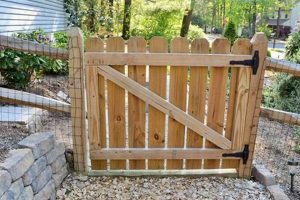The creation of personalized neck adornments using individual components offers a distinct form of self-expression. This activity involves selecting and assembling various decorative elements, often referred to as charms, onto a chain or cord to produce a unique piece of jewelry. For example, one might choose miniature representations of meaningful objects, letters, or birthstones to reflect personal interests or significant life events.
Such endeavors provide a creative outlet and a tangible representation of personal identity. Historically, the practice of wearing symbolic pendants dates back centuries, with different cultures attributing varying meanings to these objects. The ability to curate and construct wearable art allows for individualized design choices, circumventing the limitations of mass-produced items. The resultant piece serves not only as an accessory but also as a conversation starter and a potential keepsake.
The following discussion will explore various facets of this craft, including material selection, techniques for assembly, and design considerations that contribute to a successful outcome. Guidance will also be provided regarding sourcing supplies and identifying appropriate tools for the process.
Essential Guidance for Crafting Personalized Neck Adornments
The construction of bespoke neck adornments requires careful consideration of several key elements. The following tips are intended to enhance the creative process and ensure a professional and enduring finished product.
Tip 1: Material Compatibility is Paramount. Ensure all components used in the adornment are composed of compatible metals to prevent tarnishing or adverse reactions. For instance, pairing sterling silver with base metals can lead to premature oxidation of the silver. Always verify material specifications prior to assembly.
Tip 2: Chain Selection Dictates Aesthetic and Durability. The chain’s gauge, style, and material strength must align with the weight and design of the charms. A delicate chain is ill-suited for heavy or numerous charms, potentially leading to breakage. Opt for durable chain types like cable or box chains for heavier designs.
Tip 3: Bail Size Influences Charm Suspension. The bail, the small loop that connects the charm to the chain, must be appropriately sized to accommodate the chain. Using a bail that is too small will restrict movement and create an undesirable appearance. Larger bails offer greater flexibility and aesthetic appeal.
Tip 4: Balance Charm Distribution for Visual Harmony. The arrangement of charms along the chain should strive for visual equilibrium. Uneven distribution can cause the necklace to hang improperly or appear lopsided. Consider the size, weight, and color of each charm when planning the layout.
Tip 5: Secure Jump Rings to Prevent Loss. Jump rings, used to attach charms and clasps, must be properly closed and soldered if possible, to ensure they will not open unexpectedly. A properly secured jump ring minimizes the risk of losing valuable charms.
Tip 6: Employ Proper Tools for Component Manipulation. Needle-nose pliers, chain-nose pliers, and wire cutters are essential for precise manipulation of small components. Using the correct tools prevents damage to the materials and ensures a clean, professional finish.
Tip 7: Consider the Clasp’s Functionality and Security. The clasp should be both aesthetically pleasing and functionally reliable. Lobster clasps and toggle clasps offer enhanced security compared to simple spring ring clasps. The clasp’s size should also be proportional to the chain and the overall design.
By adhering to these guidelines, creators can produce durable and visually appealing neck adornments that reflect individual style while withstanding the rigors of daily wear. This attention to detail ensures that the finished piece will be cherished for years to come.
The subsequent sections will delve into advanced design techniques and explore strategies for maximizing the creative potential of personalized neck adornments.
1. Component Selection
Component selection is a foundational aspect of creating personalized neck adornments. The choices made regarding individual elements directly influence the aesthetic appeal, structural integrity, and overall value of the finished piece.
- Material Quality and Longevity
The selection of high-quality materials ensures the adornments longevity and resistance to wear. For example, using sterling silver or gold-filled components offers greater tarnish resistance compared to base metals, prolonging the necklace’s lifespan and maintaining its visual appeal. In contrast, opting for inferior materials can lead to discoloration, breakage, and a diminished aesthetic over time.
- Aesthetic Harmony and Cohesion
Selecting components that complement each other in terms of color, shape, and style is critical for achieving a cohesive design. A deliberate choice of beads, charms, and findings that share a common theme or color palette results in a more visually pleasing and harmonious necklace. Conversely, haphazardly combining disparate elements can create a disjointed and unattractive final product.
- Structural Compatibility and Functionality
Ensuring that the selected components are structurally compatible is essential for the necklace’s functionality. For instance, using jump rings that are appropriately sized for the charm’s bail and the chain’s links prevents breakage and ensures smooth movement. Similarly, choosing a clasp that is secure and easy to operate contributes to the overall usability of the neck adornment.
- Personal Expression and Symbolism
Component selection provides an opportunity for personal expression and the incorporation of meaningful symbolism. Choosing charms that represent significant interests, hobbies, or memories allows the wearer to create a truly unique and personalized piece. Including birthstones, initials, or symbolic motifs adds a deeper layer of personal significance to the neck adornment.
The thoughtful consideration of material quality, aesthetic harmony, structural compatibility, and personal symbolism during component selection elevates the creation of personalized neck adornments beyond a mere craft project, transforming it into a medium for self-expression and the creation of enduring keepsakes. The final product embodies not just the creator’s aesthetic sensibilities but also their personal narrative and values.
2. Chain Material
The selection of chain material is a critical determinant in the overall quality, durability, and aesthetic of a self-assembled charm necklace. The chain functions not only as the structural foundation upon which charms are displayed but also contributes significantly to the visual character of
the piece. Inadequate chain selection can lead to premature breakage, tarnishing, and an unbalanced aesthetic, thereby diminishing the value and longevity of the charm necklace. For example, a delicate, low-gauge chain is ill-suited for supporting numerous or heavy charms, increasing the likelihood of structural failure. Conversely, a robust, visually dominant chain may overshadow the individual charms, negating their intended effect. The material’s inherent properties, such as tensile strength, tarnish resistance, and color, directly impact the necklace’s performance and appearance over time.
Several practical considerations guide appropriate chain material selection. Stainless steel offers excellent durability and tarnish resistance, making it a suitable choice for everyday wear. Sterling silver provides a classic aesthetic, but requires regular maintenance to prevent tarnishing. Gold-filled chains offer a cost-effective alternative to solid gold, combining durability with a refined appearance. The chain’s link style also influences its suitability. Cable chains are versatile and strong, while box chains offer a more refined and contemporary look. Bead chains, while visually interesting, are often less durable and may not be suitable for heavier charms. The compatibility of the chain’s metal with the charm materials is also a crucial consideration to prevent galvanic corrosion, which can occur when dissimilar metals come into contact.
In conclusion, the chain material is an integral component of a self-assembled charm necklace, significantly affecting its structural integrity, aesthetic appeal, and long-term durability. The selection process necessitates careful consideration of material properties, link style, and compatibility with the charms. Choosing a chain that complements the charms in both form and function ensures a cohesive and enduring piece. Challenges in selection often arise from balancing aesthetic preferences with practical durability requirements; however, informed decision-making ultimately contributes to a higher-quality and more satisfying finished product.
3. Bail Compatibility
Bail compatibility represents a crucial, and frequently overlooked, aspect of successful personalized neck adornment creation. The bail, a small connecting component, links the charm to the necklace chain. Incompatibility in size or material between the bail and other components creates both functional and aesthetic problems. A bail with an aperture too narrow for the chain prevents attachment, negating the charm’s inclusion. A bail constructed from a dissimilar metal can induce galvanic corrosion, weakening the connection and potentially damaging both charm and chain. Failure to address these factors results in structural instability and aesthetic disharmony, reducing the overall quality of the finished piece. Consider, for example, a silver charm coupled with a base metal bail and a gold chain; the visual discrepancy diminishes the perceived value, while the differing material properties accelerate corrosion at the points of contact.
Practical application of bail compatibility principles extends to several key areas. Prior to assembly, meticulous measurement of both chain thickness and bail aperture is essential. Selection of bails crafted from materials compatible with both the charm and the chain mitigates the risk of galvanic corrosion. Furthermore, attention to the bail’s design contributes to the necklace’s overall aesthetic. A well-chosen bail complements the charm’s style and enhances its presentation, whereas a poorly matched bail detracts from the piece’s visual appeal. Jewelry supply retailers offer a wide array of bail sizes, styles, and materials to accommodate diverse design preferences and material requirements. Online resources, including tutorials and forums, provide additional guidance on proper bail selection and attachment techniques.
In summary, bail compatibility is not merely a trivial detail but rather a fundamental consideration in the creation of durable, aesthetically pleasing personalized neck adornments. Neglecting this aspect undermines the integrity of the finished product, potentially leading to premature failure and diminished visual appeal. Addressing bail compatibility through careful measurement, material selection, and design consideration ensures a higher-quality, longer-lasting, and more visually satisfying result. The long term value of your DIY charm necklace will depend on your attention to this key element.
4. Charm Arrangement
The deliberate arrangement of charms on a self-assembled neck adornment directly influences its aesthetic appeal, balance, and overall narrative. Strategic placement transforms a collection of individual components into a cohesive and visually engaging piece, reflecting the wearer’s personal style and intended message.
- Symmetry and Asymmetry
Symmetrical arrangements, with charms mirroring each other on either side of a central focal point, convey a sense of order and balance. Conversely, asymmetrical arrangements, where charms are intentionally placed off-center or in seemingly random patterns, create a more dynamic and visually stimulating effect. The choice between symmetry and asymmetry depends on the desired aesthetic and the specific characteristics of the charms being used. For example, a necklace featuring charms of varying sizes and shapes may benefit from an asymmetrical arrangement to prevent a cluttered appearance.
- Spacing and Density
The spacing between charms significantly impacts the necklace’s overall visual density. Closely spaced charms create a denser, more intricate look, while widely spaced charms allow each individual element to stand out. Careful consideration of spacing ensures that the charms are neither overcrowded nor too sparse, achieving a harmonious balance. If the necklace features larger charms, providing ample space between each prevents a bulky or cumbersome appearance.
- Color and Texture
Strategic use of color and texture enhances the visual interest and depth of a charm arrangement. Grouping charms with complementary colors or contrasting textures creates a visually appealing effect. Varying the texture of the charms, such as combining smooth polished surfaces with rougher, more textured elements, adds tactile dimension. A necklace featuring charms predominantly in cool tones, such as blues and greens, might benefit from the addition of a few warmer-toned charms, like gold or copper, to create visual contrast and prevent monotony.
- Narrative Flow and Symbolism
Charm placement can be used to create a narrative flow or convey symbolic meaning. Arranging charms in a chronological order, representing significant life events or milestones, tells a personal story. Grouping charms with related themes or symbols reinforces a particular message or idea. The individual charms may represent personal values or life events to the wearer.
In conclusion, thoughtful charm arrangement elevates a simple self-assembled neck adornment into a personalized work of art. By carefully considering symmetry, spacing, color, texture, and narrative flow, creators can transform a collection of individual components into a cohesive and meaningful piece that reflects their unique style and personal story. A well-executed charm arrangement enhances the necklace’s aesthetic appeal, ensures visual balance, and communicates the wearer’s intended mes
sage.
5. Closure Security
Closure security is a paramount consideration in the creation and enjoyment of a self-assembled charm necklace. The closure, typically a clasp, serves as the primary mechanism for fastening the necklace around the wearer’s neck. A failure in the closure’s integrity can result in the unintended detachment and potential loss of the entire necklace, including its valuable or sentimentally significant charms. Therefore, the selection, implementation, and maintenance of a secure closure system are crucial aspects of necklace design and longevity.
- Clasp Mechanism Reliability
The mechanical design of the clasp directly influences its holding power. Lobster clasps, for example, utilize a spring-loaded gate mechanism that generally provides a more secure hold compared to simple spring ring clasps or magnetic clasps. The spring mechanism should be robust and resistant to fatigue over repeated use. Similarly, toggle clasps rely on a t-bar fitting securely into a ring; the fit should be snug and the t-bar sufficiently long to prevent accidental slippage. In the context of a charm necklace, where the combined weight of the charms exerts considerable stress on the closure, a robust and reliable clasp mechanism is essential.
- Material Strength and Durability
The material composition of the clasp significantly impacts its ability to withstand stress and resist deformation. Clasps fabricated from durable metals, such as stainless steel, sterling silver, or gold-filled alloys, offer greater resistance to bending or breaking compared to those made from base metals. The clasp should be of sufficient gauge to support the weight of the necklace and its charms without risk of failure. For instance, using a thin, lightweight clasp on a heavy charm necklace would be a precarious choice, increasing the likelihood of the clasp deforming or breaking under the load.
- Proper Attachment Techniques
The method used to attach the clasp to the necklace chain profoundly influences its security. Jump rings, small circular connectors, are commonly used for this purpose. However, simply opening and closing a jump ring can create a weak point prone to separation. Ideally, jump rings should be soldered closed to create a permanent and secure connection. Alternatively, using split rings, which resemble miniature key rings, provides a more secure connection than a standard jump ring. Insufficient attachment techniques are common failings, leading to preventable losses of DIY charm necklaces.
- Regular Inspection and Maintenance
Periodic inspection of the closure is essential to identify potential weaknesses or signs of wear. The clasp mechanism should be checked for proper function, and any loose or damaged components should be repaired or replaced promptly. Jump rings should be examined to ensure they remain securely closed. Over time, dirt and debris can accumulate within the clasp mechanism, impairing its function; regular cleaning with a soft brush and mild soap can help maintain its performance. By inspecting and maintaining the closure, wearers extend the life and security of their charm necklace.
The aforementioned factors highlight the multifaceted nature of closure security in the context of a self-assembled charm necklace. Neglecting any one of these aspects can compromise the integrity of the entire piece, resulting in the loss of cherished charms. Therefore, a holistic approach, encompassing careful selection of clasp mechanisms and materials, meticulous attention to attachment techniques, and diligent maintenance, is crucial to ensure the lasting security and enjoyment of the finished necklace.
6. Tool Proficiency
Tool proficiency is intrinsically linked to the successful creation of a self-assembled charm necklace. The ability to effectively utilize jewelry-making tools directly influences the structural integrity, aesthetic quality, and longevity of the finished piece. Inadequate tool handling often results in damaged components, insecure connections, and a diminished overall appearance. For example, improper use of pliers can lead to scratched or misshapen jump rings, compromising the security of charm attachments. Similarly, dull or incorrectly utilized wire cutters produce jagged edges, detracting from the necklace’s aesthetic refinement. These seemingly minor imperfections accumulate, negatively impacting the final product and potentially causing premature failure. Therefore, a foundational understanding of tool functionality and appropriate usage is not merely a supplementary skill but a prerequisite for crafting high-quality charm necklaces.
The practical applications of tool proficiency extend across various stages of necklace construction. Accurate measurement and cutting of chain require specialized tools like chain-nose pliers and wire cutters, ensuring precise lengths and clean cuts. Securely closing jump rings necessitates the use of two pairs of pliers one to grip and stabilize, and the other to close the ring without distorting its shape. Setting delicate gemstones or beads into charm settings demands precision and control, attainable only through proficiency with specialized tools like bezel-setting pliers and burnishers. Furthermore, achieving a polished and professional finish often involves employing polishing cloths, rotary tools with buffing attachments, and chemical cleaners, each requiring careful handling to avoid damaging delicate materials.
In summary, tool proficiency is not an ancillary skill but an indispensable element in the creation of durable and visually appealing charm necklaces. Lack of competence in this area directly translates to compromised structural integrity, diminished aesthetic quality, and increased risk of component damage. Mastering essential jewelry-making tools empowers creators to execute designs with precision, ensuring the longevity and beauty of their handcrafted pieces. While the initial investment in quality tools and the time dedicated to learning proper techniques represent a commitment, the resultant improvement in craftsmanship and the enhanced durability of the finished necklace justifies the effort. A successful DIY charm necklace is a testament to the tool and the skill of the user.
Frequently Asked Questions
This section addresses common inquiries regarding the creation of personalized charm necklaces. The information provided aims to clarify key aspects of the process, ensuring a more informed and successful outcome.
Question 1: What is the optimal method for preventing tarnish on a completed charm necklace?
Tarnish prevention involves several strategies. Firstly, select materials known for tarnish resistance, such as stainless steel or gold-filled metals. Secondly, store the necklace in an airtight container or anti-tarnish bag when not in use. Thirdly, avoid exposing the necklace to harsh chemicals, such as chlorine or cleaning agents. Regular cleaning with a jewelry polishing cloth further mitigates tarnish formation.
Question 2: How does one determine the appropriate chain length for a charm necklace?
Chain length depends on individual preferences and intended style. A shorter chain, typically 16-18 inches, sits close to the collarbone, suitable for highlighting the neckline. A longer chain, ranging from 20-24 inches, drapes lower on the chest, offering greater visibili
ty of the charms. Consider the wearer’s height and body type when selecting the appropriate length. A paper and ruler may be used to measure preferred length.
Question 3: What constitutes a secure method for attaching charms to a necklace chain?
Secure attachment requires the use of robust jump rings. These should be fully closed and, ideally, soldered to prevent accidental opening. Split rings, resembling miniature keyrings, offer enhanced security compared to standard jump rings. Proper closure and material strength are essential to prevent charm loss.
Question 4: Are there specific tool requirements for assembling a charm necklace?
Essential tools include chain-nose pliers for manipulating jump rings, wire cutters for trimming excess wire, and round-nose pliers for creating loops. Precision and control are necessary to avoid damaging delicate components. Quality tools contribute to a more professional and durable finished product. Work surface protection is recommended.
Question 5: What are the key considerations when selecting charms for a necklace?
Considerations include material compatibility, size proportionality, and thematic coherence. Charms should be constructed from materials that complement the chain and avoid galvanic corrosion. The size of the charms should be proportionate to the chain’s gauge to prevent excessive weight or imbalance. Thematic coherence ensures a visually harmonious and meaningful composition.
Question 6: How does one address a broken necklace chain or a detached charm?
A broken chain can often be repaired using chain-nose pliers and replacement jump rings. Detached charms can be reattached using the same method, ensuring the jump ring is securely closed. For more complex repairs, consider seeking assistance from a professional jeweler to ensure structural integrity and aesthetic restoration.
In summary, creating a durable and aesthetically pleasing charm necklace requires careful attention to material selection, construction techniques, and ongoing maintenance. Adhering to these guidelines enhances the longevity and enjoyment of the finished piece.
The subsequent sections will explore advanced design techniques and provide insights into optimizing the creative potential of personalized neck adornments.
Conclusion
This exploration of “diy charm necklace” creation has emphasized critical factors influencing its success. Material selection, encompassing chain and component compatibility, determines longevity. Assembly techniques, particularly jump ring closure and clasp security, dictate structural integrity. Design considerations, including charm arrangement and balance, influence aesthetic appeal. Neglecting these elements compromises the final product’s quality and durability.
The creation of personalized neck adornments represents more than a mere craft; it embodies a tangible expression of individuality. Therefore, meticulous application of these principles ensures a finished piece that is not only aesthetically pleasing but also enduring, serving as a lasting testament to personal creativity and attention to detail. Continued exploration and refinement of these techniques will undoubtedly elevate the art of personalized jewelry making.







